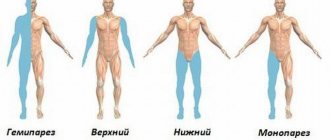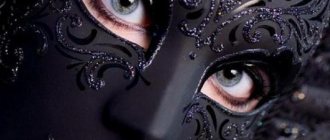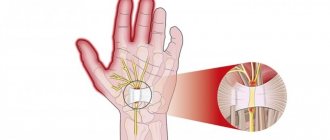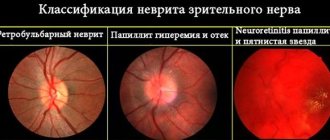Neuritis of the facial nerve is the most common and ranks second among various types of pathologies of the peripheral nervous system. It is manifested mainly by dysfunction of the facial muscles on the affected side. According to WHO, there are from 13 to 24 cases of facial nerve damage per 100,000 population, equally common in both men and women. People of all ages are susceptible to the disease. Such frequent damage to the facial nerve is often facilitated by its anatomical and topographical features.
The facial nerve (n. facialis) is a mixed nerve, consisting mainly of motor fibers that innervate the facial muscles, and the intermediate nerve, which contains secretory fibers that provide parasympathetic innervation of the lacrimal, as well as the submandibular, sublingual salivary glands and sensitive taste fibers for the anterior 2/3 of the tongue. There is also a small number of sensory animal fibers that take part in the innervation of the auricle, external auditory canal and mastoid process.
The facial nerve passes in a close bone (without soft tissue surrounding) canal with a length of 30-33 mm, almost constantly filling about 70% of the diameter of the canal lumen, and makes two external bends. The distal part of the facial nerve canal in front of the stylomastoid foramen, through which the nerve exits to the base of the skull, narrows somewhat due to circularly located connective tissue cords. The characteristics of blood and lymph circulation are of great importance. In a narrow bone canal, the arteries vascularizing the facial nerve are deprived of the opportunity to expand, responding to the neurovascular reactions of the parent bed (main and external carotid arteries). Lymph nodes grouped in the area where the nerve exits lead to difficulty in lymphatic and venous drainage. The presented data allow us to consider the syndrome of damage to the facial nerve in most cases as a tunnel syndrome of nerve entrapment in a narrow bone canal, and the disease of the facial nerve can be called neuropathy of the facial nerve.
Bell's palsy: causes, symptoms and treatment
Bell's palsy or facial neuropathy is a disease that manifests itself as paresis of the facial muscles innervated by the facial nerve. The muscles on one side of the face simply stop moving (plegia) or weaken (paresis).
The patient's face becomes expressionless, mask-like, emotional reactions are invisible on it: the person cannot express surprise, frown, wrinkle his forehead, smile, wink. In severe cases, the eyelids of the affected eye do not close even during sleep, which can lead to the development of keratitis and conjunctivitis.
Saliva constantly leaks from the mouth, and there is difficulty in eating and drinking.
The disease occurs with a frequency of about 30 cases per 100 thousand population; no strict dependence on gender has been identified. People of different age groups get sick, but some increase in incidence is observed after 70 years.
Bell's palsy, once it appears, is prone to a recurrent course, i.e. the disease may return after some time even after complete recovery.
Unfortunately, it is not always possible to achieve full restoration of the function of facial muscles, especially in severe cases. If initially there was almost complete immobilization of the muscles, the probability of successful treatment is only 15-20%.
Treatment is long and even in the mildest cases can take several months. Facial nerve neuropathy, especially if there is no organic brain damage, is not prone to progression.
Causes of paralysis
In 70-80% of cases, the cause of facial paralysis cannot be determined. It has been noted that the disease can develop after:
- hypothermia, most often patients indicate a recent cold, exposure to a draft, a common cause is driving in a car with an open side window;
- viral infection, especially caused by the herpes simplex virus;
- strong psycho-emotional experience;
- traumatic brain injury, not necessarily at the time of its occurrence, but even several years later;
- diseases of the middle ear (otitis media, mastoiditis);
- infections in the oral cavity (long-term untreated caries, purulent processes).
Less commonly, Bell's palsy can result from:
- diabetes mellitus;
- pregnancy;
- multiple sclerosis;
- tumors;
- arterial hypertension;
- blood diseases.
However, regardless of the cause, the pathogenesis of the disease is almost the same. Bell's palsy occurs due to compression of the facial nerve in the narrow bony canal through which it passes through the cranial cavity. As a result of exposure to a provoking factor, swelling of the nerve tissue, pinching and ischemia develop. And depending on the severity of these pathological processes, the clinical picture of the disease will develop.
Bell's Palsy Symptoms
The disease begins acutely, symptoms increase over a period of time from several hours to 1-2 days. Some time before the development of the main manifestations of the disease there may be:
- aching pain in the area behind the ear, radiating to the same half of the face;
- increased salivation (hypersalivation);
- lacrimation or, conversely, dry eyes;
- increased sensitivity to sounds, when even whispered speech begins to cause discomfort;
- loss or distortion of taste; a person may not feel the taste of food.
Often patients do not pay due attention to these signs, mistaking them for manifestations of a cold.
Subsequently, the main, most formidable and frightening symptom arises - unilateral prosoparesis - paralysis or weakness of the facial muscles of one half of the face. In this case, a person cannot:
- close your eyes completely (a white stripe of the sclera remains visible, this is lagophthalmos, “hare’s eye”, or Bell’s sign - hence the name of the disease);
- wrinkle your forehead;
- frown;
- puff out your cheeks (the cheek on the affected side does not move);
- take food and liquid fully, everything pours out through the corner of the mouth (due to weakness of the lips).
It should be remembered that the presence of all of the above symptoms is not mandatory; everything will depend on the level of damage to the facial nerve.
Severity of Bell's palsy:
- mild: only emotional reactions are lost, but if you ask a person to move his facial muscles on command, there is no pathology;
- moderate: weakening of voluntary movements;
- severe: almost complete immobilization of the affected facial muscles.
Treatment of facial nerve neuropathy
Since the death of nerve cells occurs very quickly, and they take a long time to recover, treatment should begin as soon as possible after the first signs of the disease appear and the correct diagnosis is established.
Indeed, under the guise of damage to the facial nerve, an acute cerebrovascular accident can occur. If you suspect the presence of a disease, a person should stand in front of a mirror and evaluate the symmetry of all the folds on his face.
Next, you need to try to do simple exercises: frown your forehead, close your eyes, puff out your cheeks, smile. If deviations are detected, you should immediately consult a neurologist.
The presence of neuropathy of the facial nerve is an indication for urgent hospitalization in the neurological department of the hospital. Therapy includes:
- non-steroidal anti-inflammatory drugs, which also have a good analgesic effect, intramuscularly or in tablet form (diclofenac, meloxicam);
- hormones (hydrocortisone, prednisolone), diuretics (furosemide) to reduce swelling of the affected nerve;
- vascular (trental, pentoxifylline) to improve blood circulation in the area of inflammation;
- drugs that help accelerate the transmission of neuromuscular impulses (neuromidin, ipigrix);
- B vitamins (milgamma).
Physiotherapeutic treatment also plays an important role:
- electrophoresis with vascular (pentoxifylline), hormonal (hydrocortisone) and nerve transmission improving drugs (neuromidin) on the affected half of the face;
- UHF currents;
- Exercise therapy is a set of special exercises for training the facial muscles, performed by the patient independently, standing in front of a mirror. In muscles that are deprived of innervation and are in a stationary or sedentary state for two weeks, a contracture begins to form, which threatens to immobilize them;
- acupuncture;
- massage.
Surgical treatment - surgical decompression of the nerve, used for:
- complete plegia of the facial nerve;
- damage to more than 90% of nerve bundles according to electroneuromyographic studies (ENMG);
- no effect of treatment within a week.
Thus, success in treatment depends on the timeliness of medical care and the efforts of the patient himself.
diagnosis of neuropathy, treatment of neuropathy, Facial nerve, facial nerve neuropathy, Bell's palsy, Facial nerve paralysis, causes of neuropathy, causes of Bell's palsy, symptoms of neuropathy, symptoms of Bell's palsy, remedies for neuropathy
Source: https://my-znahar.com/iz-za-chego-razvivaetsya-paralich-bella-chto-delat.html
General information
Bell's palsy was first discovered in 1821.
This disease was discovered by a doctor from Scotland, Charles Bellom. In honor of him, pathology acquired its name. Bell's palsy is a disorder of the peripheral nervous system. It affects the facial nerve. Bell's palsy is a very rare condition. There are only 15 patients per 100,000 people. The main clinical manifestation of the disease is weakness of the facial muscles, the manifestation of an asymmetrical smile, the person cannot completely close his eyes. He may experience increased lacrimation or, conversely, dryness of the mucous membrane of the eye. There is a decrease in hearing acuity and loss of taste sensitivity.
Bell's palsy is a very rare condition. There are only 15 patients per 100,000 people. The main clinical manifestation of the disease is weakness of the facial muscles, the manifestation of an asymmetrical smile, the person cannot completely close his eyes. He may experience increased lacrimation or, conversely, dryness of the mucous membrane of the eye. There is a decrease in hearing acuity and loss of taste sensitivity.
How can Bell's palsy be dangerous?
In neurology, there are a large number of diseases of unknown origin (idiopathic), the causes of which are not fully understood. Such diseases include Bell's palsy. What is Bell's palsy? This is a disease that is characterized by weakening of the facial muscles on one or both sides.
General information
This syndrome has been known in medical practice for quite some time; it was first described in 1821 by an anatomist from Scotland, Charles Bell (where it got its name). This disease belongs to the peripheral nervous system and mainly affects the facial nerve.
The disease affects people of any age, however, the majority of those affected are over 60 years old. This is most likely due to the presence of greater health problems in this category of people, rather than to genetic preferences for the disease.
The disease is relatively rare. If we talk about adults, then for every 100 thousand healthy people there are 15–20 sick people. In the case of children, per 10 thousand there are 5–7 people who have this paralysis.
It is worth noting that more cases occur in the cold season.
Causes
As often happens with idiopathic types of diseases, the exact cause of the disease is not completely clear. Nevertheless, thanks to the accumulated experience, there is evidence that this disease occurs against the background of a viral infection of the body or weakened immunity, especially during the period of other infectious diseases.
In addition, the reasons that can provoke the disease are:
- facial injuries;
- hypothermia of the body;
- problems with arterial circulation;
- cerebral atherosclerosis;
- hypertension;
- mumps;
- otitis;
- inflammation of the brain caused by various factors (encephalitis, meningitis, etc.).
In addition, in some cases, this syndrome was observed after the use of painkillers.
What happens to nerves during paralysis
Thus, there are four general causes of the development of the disease:
- Infectious.
- Lymphogenic.
- Hereditary.
- Ischemic (related to blood vessels).
Types of pathology
Bell's palsy has a standard classification. According to the presence of provoking factors, the disease differs into:
- Primary (occurs as an underlying disease as a result of hypothermia, problems with blood vessels, etc.).
- Secondary (occurs against the background of an infection in the body, as a side effect).
Depending on the location of the disease, it can be:
- Left-handed.
- Right-handed.
- Bilateral (in some sources it is called complete paralysis).
According to the nature of the course of the disease, the disease is:
- Acute (up to 2 weeks).
- Subacute (up to 4 weeks).
- Chronic (more than 4 weeks).
Symptoms
Symptoms of Bell's palsy appear quickly and gradually increase over 48 hours, after which they gradually begin to disappear.
At the very beginning, a person feels paralysis of one side of the face or (if we are talking about bilateral paralysis) of the entire face. The lips and tongue stop obeying the person and become “woolly.”
The patient stops speaking normally, he loses the ability to frown (wrinkles are smoothed out), he cannot close his eyes completely (when they close, the whites are clearly visible).
One of the main symptoms is pain behind the ear. This symptom occurs 1–2 days before facial paralysis (paresis) and serves as a signal of a growing problem.
In addition, the symptoms of the disease include:
- increased salivation;
- inability to bare teeth;
- smoothing the nasolabial fold;
- sensitivity to loud sounds;
- loss of tastes;
- problems with eating;
- lacrimation;
- redness of the eyes;
- numbness of the face where sensitivity is present;
- involuntary muscle contractions.
One of the signs is that the face is tilted to the healthy side when trying to tense any muscle on the face. However, this symptom is characteristic only of unilateral paralysis.
The course of the disease itself is as follows:
- Within 1-2 days, the patient begins to feel a sharp pain behind the ear (however, this is not necessary).
- During the active phase, the patient develops edema and ischemia, which lasts up to 2 days.
- After the second day, as a rule, a recovery period begins, during which swelling decreases and the facial muscles begin to contract.
Residual effects, some paresis and paralysis may remain for some time.
Diagnostics
This disease has a clear clinical picture, so already at the examination stage the doctor can make a preliminary diagnosis, which will only need to be differentiated from other similar ailments and determine the cause.
So, a neurological examination includes:
- determining the degree of damage to the facial muscles (puffing out the cheeks, closing the eyes, frowning);
- determining the presence of a “sail sign” (the doctor asks you to take a deep breath and exhale; when you exhale, a kind of puffing of the cheek is noted on the affected side);
- To differentiate the disease from the symptoms of a stroke, an examination of the face is carried out (for example, with a stroke, weakness of the lower part of the face is noted, while with Bell's palsy, weakness is observed in the entire affected part).
In addition to a neurological examination, the doctor will prescribe a comprehensive diagnosis of the body, which includes:
- radiography;
- Magnetic resonance imaging;
- rheoencephalography;
- CT scan;
- Dopplerography of cerebral vessels;
- collection of cerebrospinal fluid to determine pleocytosis.
Treatment methods
Treatment for Bell's palsy can be done at home if approved by your doctor. As a rule, the disease often goes away on its own, within a few weeks, even without medical intervention, however, if indicated, the doctor has the right to prescribe medication.
So, there are three types of treatment:
- Conservative.
- Surgical.
- Folk.
Conservative treatment
Conservative treatment is the main of the three listed options and may include:
- drug therapy;
- physiotherapy;
- massage.
If the disease does not go away within a certain period of time, the doctor prescribes the patient a medicine or a group of medicines that will promote a speedy recovery.
So, the medications that are used in this situation are:
- hormonal (nerobil, metipred, prednisolone);
- antispasmodics (no-spa);
- decongestant (dibazol);
- headache medications (analgin, aspirin, citramon);
- analgesics (painkillers);
- complex of vitamins;
- medications to reduce dry eyes.
Massage of the cervical-collar area is used as a massage, since in most cases inflammation in this part of the body provokes the development of the disease
It is extremely unwise to prescribe medications for yourself, and even more so for a child, as this can only cause harm and ultimately lead to surgical intervention.
Surgery
As for surgical intervention, it is prescribed if the symptoms of the disease cannot be cured for more than a month. The fact is that if symptoms persist for a long time, there is a possibility of complications in the form of lifelong persistence of symptoms. In the event of such a threat, it is necessary to quickly eliminate the problem not with medications, but with surgical intervention.
The operation involves microscopic decompression of the facial nerve.
Decompression - removing compression
Often, to gain access to the nerve itself, it is necessary to remove the bone that blocks access to it.
If the disease is already prolonged, plastic surgery may be performed.
Recovery after surgery does not take a long time, however, the patient needs to perform special exercises for the facial muscles and use a special electrical stimulator.
ethnoscience
Bell's palsy can be treated not only in a medical facility, but also with traditional methods. The most important thing is that the attending physician knows about this fact and approves this treatment option.
The basis of home remedies are sedatives and tinctures, which include:
To prepare a sedative tincture you will need the following:
50 ml of hawthorn fruit tincture
50 ml peony flower tincture
50 ml calendula tincture
50 ml motherwort
25 ml Corvalol
1–2 tsp. honey
All ingredients are mixed and taken 1 tsp. at night for 3 months.
- tincture of raspberry leaves;
To prepare you will need:
Several raspberry stems and leaves
200 g vodka
Pour the raw materials with vodka and leave for 9 days. Strain before use. The admission procedure is as follows:
The first 10 days, 20 drops 3 times a day 30 minutes before meals
Next 10 days 30 drops
Next 10 days 50 drops
Next, 30 drops.
The course is 3 months
An excellent remedy for getting rid of this disease is the use of heat. Place cereal or salt in a tight bag and heat it to a tolerable temperature. It is necessary to warm the affected area for at least 10 minutes.
In addition, you can treat with sea buckthorn oil. This oil is applied in a circular motion to the affected area until completely rubbed in. The course of treatment is at least a month.
Possible complications
Despite the mildness of the disease, in the absence of timely and correct treatment there is a possibility of complications developing.
So, the consequences of Bell's palsy can be:
- irreversible damage to the facial nerve;
- partial or complete loss of vision;
- affecting the second half of the face (with a unilateral form of the disease);
- persistence of symptoms of the disease until the end of life;
- uncontrolled muscle contraction (the patient’s eyes may close when smiling).
Nevertheless, the prognosis is quite comforting - in approximately 75% of cases, complete recovery occurs.
Prevention
Like any disease, this ailment can be prevented; for this it is necessary to follow simple preventive recommendations, including:
- strengthening and increased attention to your immunity;
- exception of being in drafts, in cold rooms and on the street in the cold season without clothes;
- timely treatment of all diseases (correct treatment of these diseases);
- promptly consult a doctor if you notice signs of paralysis in yourself.
So, despite the fact that this disease is not life-threatening, the presence of unpleasant consequences can seriously complicate life. Don’t delay your visit to the doctor and try to get rid of the disease on your own, take care of yourself and your health, and get treated correctly.
Source: https://nervivporyadke.ru/pns/paralich-bella.html
Diagnostics
This disease has a clear clinical picture, so already at the examination stage the doctor can make a preliminary diagnosis, which will only need to be differentiated from other similar ailments and determine the cause.
So, a neurological examination includes:
- determining the degree of damage to the facial muscles (puffing out the cheeks, closing the eyes, frowning),
- determining the presence of a “sail sign” (the doctor asks you to take a deep breath and exhale; when you exhale, a kind of puffiness of the cheek is noted on the affected side),
- To differentiate the disease from the symptoms of a stroke, an examination of the face is carried out (for example, with a stroke, weakness of the lower part of the face is noted, while with Bell's palsy, weakness is observed in the entire affected part).
In addition to a neurological examination, the doctor will prescribe a comprehensive diagnosis of the body, which includes:
- radiography,
- Magnetic resonance imaging,
- rheoencephalography,
- CT scan,
- dopplerography of cerebral vessels,
- collection of cerebrospinal fluid to determine pleocytosis.
Bell's palsy: causes, symptoms, effective treatments
Bell's palsy is a disorder of the facial nerve that in most cases causes one-sided paralysis. Sometimes there is weakness of the facial muscles on one side. This pathology usually develops rapidly. It typically affects people over the age of sixty, but Bell's palsy can occur at any age.
Typically, the pathology does not require special therapy: it goes away on its own in 1-8 weeks - this is the period required to restore the functioning of the facial nerve.
However, if you are older, it may take longer to recover.
In the affected area of the face, persistent muscle contraction sometimes appears, and after a certain period of time the paralysis returns again.
Causes of Bell's palsy
The exact causes of this disease have not been fully studied. It is only known that the mechanism for the appearance of such paralysis is related to swelling of the facial nerve, which occurs as a result of an immune disorder or viral infection.
Most often, infection leads to the development of this disease. Also factors causing its development are traumatic injuries and hypothermia.
Sometimes Bell's palsy is associated with impaired arterial circulation due to cerebral atherosclerosis or hypertension.
This pathology can be a complication of mumps, otitis media, and inflammatory processes occurring in the brain. Sometimes facial nerve paralysis develops as a result of the injection of painkillers into the inferior alveolar nerve.
Treatment
Treatment tactics for Bell's palsy are chosen based on the degree of nerve damage. If some functions are preserved, it is possible to fully recover within a few months. In other cases, drug or surgical treatment is used.
Conservative treatment methods
In case of complete paralysis, it is worth performing electromyography and studying nerve conduction. If it is present, the chances of full recovery are 90%. In other cases, the probability of a favorable outcome does not exceed 20%.
Drug therapy involves the use of glucocorticoids in the early stages - these drugs are administered within 48 hours of the onset of the disease. Thanks to them, it is possible to reduce the duration and severity of residual paralysis.
The most effective in this case is prednisolone, which is prescribed in a dosage of 60-80 mg once a day. This lasts 1 week. After this, the dose is gradually reduced over 2 weeks.
Antiviral agents may also be prescribed to help fight the herpes virus. It could be:
- acyclovir;
- famciclovir;
- valacyclovir.
In order to prevent drying out of the cornea, instillation of an isotonic solution or natural tears may be prescribed. A bandage is also used to cover the affected eye, especially at night.
On days 5-7 of the disease, vitamin preparations are prescribed, and on days 7-10 - drugs to improve nerve conduction.
The following procedures should be a mandatory part of treatment:
- laser therapy;
- infrared rays;
- physiotherapy;
- UHF electric field;
- sinusoidal modulated currents;
- massage of the collar area;
- ultrasound;
- acupuncture.
Surgical intervention
If signs of the disease persist for more than a month, surgery may be necessary. If surgery is delayed for more than three months, the pathology may persist forever.
In this case, microscopic decompression of the facial nerve . In this procedure, the doctor removes the bone that covers the facial nerve to open the sheath. An electrical stimulator can be used to speed up recovery processes.
After such an intervention, the physiotherapist prescribes special exercises for the muscles of the forehead, cheeks, mouth, eyelids, and chin. Thanks to these procedures, complete recovery can be achieved.
In people who have Bell's palsy for more than 2 years, the facial muscles do not function. Such patients are indicated for plastic reconstruction, which is carried out using transposition of the facial nerve on the other side.
In addition, the Gracilis muscle, which is located on the inner surface of the thigh, is transplanted. It can be transplanted onto the face with blood vessels and nerves.
This surgery is used to reconstruct the middle of the forehead and eyes in people who have congenital or long-standing Bell's palsy.
It is with these types of paralysis that the native facial muscles are completely absent due to serious atrophy or congenital causes.
Elena Malysheva in her program talks in detail and clearly about the features of this disease:
Bell's palsy is considered a fairly serious pathology. Sometimes it can go away on its own, in other cases it leads to dangerous complications, as a result of which the facial muscles atrophy. If you do not start treatment for this disease in a timely manner, it may remain forever or there will be a need for surgical intervention.
To prevent this from happening, when the first manifestations of pathology occur, you must seek help from a specialist. As preventive measures, it is worth advising to avoid infectious diseases, hypothermia, and also treat arterial hypertension in a timely manner.
Source: https://gidmed.com/bolezni-nevrologii/narushenija-dvigatelnih-fynkcij/lechenie-paralicha-bella.html
Classification
The classification of Bell's palsy is divided into primary and secondary. The primary form occurs as an independent disease. It can develop due to hypothermia of the body, disruption of blood vessels.
Secondary pathology manifests itself as a complication of an existing disease or severe infection.
Bell's palsy can affect the left, right, or both sides of the face; this classification is based on the concentration of the inflammation. Some doctors call bilateral facial nerve paralysis complete. In its course, the disease can be acute, lasting up to two weeks, subacute - up to 4 weeks, and chronic, when symptoms persist for more than 4 weeks.
Based on the causes of Bell's palsy, there are the following forms of the disease:
- primary - in such situations, the inflammatory process develops in a completely healthy person. This often occurs against the background of prolonged hypothermia;
- secondary – is a consequence of the course of a disease.
Secondary neuritis of the facial nerve is divided into:
- infectious;
- traumatic;
- intoxication;
- ischemic;
- compression
Also, such a disease can be unilateral or bilateral (this option occurs in only 2% of patients).
Bell's palsy: causes, symptoms and treatment, consequences
Bell's palsy is a serious condition that results in unilateral paresis of the facial muscles. This disease is characterized by rapid development.
Causes of the disease
With this paralysis, the causes have not been reliably determined, so doctors talk about the idiopathic nature of this disorder.
The impetus for the development of facial paralysis can be:
- infectious diseases;
- severe hypothermia;
- purulent diseases of the middle ear;
- meningitis;
- tumor neoplasms;
- atherosclerosis.
The cause of the development of damage to the facial nerve may be Moebius and Guyon-Baré syndrome. The first is characterized by a congenital anomaly of the facial nerves, as a result of which the facial muscles are undeveloped, and with Guyon-Barré syndrome, multiple lesions of the nerve roots are noted, leading to the development of paralysis.
One of the likely causes of facial paralysis is an infectious disease in which swelling of the facial nerve develops.
Symptoms of paralysis
Bell's palsy is characterized by the following symptoms:
- discomfort behind the ear;
- weakening of the muscles on one side of the face;
- lack of facial expressions;
- impaired motor function of the eyelid on the affected part of the face;
- local numbness of the skin.
Mild pain behind the ear is the initial symptom of the disease and appears before the development of visible manifestations of the disease. Then the muscles on the affected side of the face gradually weaken.
After some time, facial muscle movements become impossible.
Bell's palsy is characterized by impaired eyelid mobility, as a result of which a person is unable to close the eye located on the affected part of the face.
The affected area becomes numb, but there is no decrease in skin sensitivity.
In some cases, there is excessive tearing, salivation and disturbances in taste.
Features of the disease
Bell's palsy occurs due to sudden swelling of the facial nerve. The reasons for this process have not yet been clarified. A feature of the disease is that in most cases the function of the facial nerve is restored on its own, without specific treatment. As a rule, this happens within one and a half to two months.
However, this does not mean that the disease does not need to be treated. Often there is repeated weakening of the muscles after independent restoration of the function of the facial nerve. Elderly people should be especially careful, since in this case there is a high probability of developing complications, as a result of which it will not be possible to completely restore the function of the nerve.
Establishing diagnosis
To make a diagnosis, you must consult a neurologist. The diagnosis is made based on an external examination and assessment of the extent of damage to the facial nerve. For this purpose, diagnostic methods are used - electromyography. This allows you to determine the degree of disturbance in the conduction of impulses along the damaged nerve.
The treatment regimen is selected individually, depending on the degree of damage.
Physiotherapeutic methods
One and a half to two weeks after the start of drug treatment, physiotherapeutic procedures are prescribed. This is necessary in order to improve local metabolic processes and relieve swelling. When treating Bell's palsy, the following are used:
- acupuncture;
- massage;
- ultrasound treatment methods;
- laser therapy.
All this helps to improve the function of the nerve and facial muscles and helps to quickly restore the patient’s facial expressions.
Surgical treatment
Surgical intervention is prescribed if drug therapy does not produce results for a long time. Usually, the basis for surgery is the lack of improvement after a month of medication treatment. During the operation, decompression of the affected nerve is performed.
To fully restore facial function, a long period of rehabilitation will be required. At this time, the patient is prescribed physiotherapy, massage and regular exercises to restore facial expressions.
If the operation was performed after long-term paralysis (more than two years), restoration of facial expressions is impossible without additional intervention, since the patient’s facial muscles do not function.
Gymnastics to restore facial expressions
There are a number of simple exercises indicated for recovery from facial neuritis.
- Raise your eyebrows high, making a surprised face, then lower them as low as possible, frowning.
- Take in as much air as possible by puffing out your cheeks, and then release the air by pressing on them with your hands.
- Close your eyes tightly, then open them wide.
- Fold your lips into a “tube”, as if whistling. At this time, puff out your cheeks and slowly release air through pursed lips.
It is recommended to open your mouth wide and stick out your tongue, smile widely, and then purse your lips. Each exercise should be repeated 10 times daily.
Prognosis and prevention
The prognosis depends on the conduction of impulses along the facial nerve. If conduction is not impaired, the prognosis is favorable, but complete recovery requires time.
If according to the results of electromyography there is no conductivity, in most cases it is impossible to restore facial functions without surgical intervention.
Even if the operation is successful, plastic correction of the affected side of the face will be necessary.
Since the causes of paralysis have not been reliably studied, the only preventive measure is timely treatment of any infectious diseases. It is also recommended to avoid hypothermia.
Source: https://NashiNervy.ru/perifericheskaya-nervnaya-sistema/prichiny-i-lechenie-paralicha-bella.html
general information
Bell's palsy refers to damage to the facial nerve, characterized by disruption of the primary functions of the facial muscles due to the action of various factors. The disease is predominantly unilateral in nature and occurs at absolutely any age (usually between 15 and approximately 40 years). Men and women are equally susceptible to this disease.
As a rule, the pathology does not require serious treatment. It goes away on its own in 1-8 weeks, since this is exactly the time needed to fully restore the functions of the facial nerve. Elderly patients may require more time.
Features of manifestations and methods of treatment of Bell's palsy
Bell's palsy is a neuritis or inflammation of the facial nerve that occurs suddenly and affects one side of the face. The disease is incurable: although the acute stage passes after a few months, complete recovery does not occur.
Paralysis leads to weakening of the facial muscles, which disappears within a week or several weeks after therapy. The disease strikes people after 60 years of age, but there are cases of earlier development if certain factors contribute to this.
Prolonged paralysis is rare and occurs mainly in patients over 80 years of age. Over time, all signs of paralysis go away, but symptoms may return unexpectedly.
Possible causes of the disease
Bell's palsy develops due to inflammation and swelling of the nerve, which occurs in the event of a viral infection or disturbances in the immune system.
Inflammation of the facial nerve can be provoked by pressure on it and ischemia in the nerve canal of the temporal part of the bone. Bell syndrome is associated with injury, hypothermia and diseases that can affect its occurrence: diabetes, HIV, stroke, tumors, abscess.
Do not forget about hereditary predisposition. The exact reasons are not fully understood.
The first signs and clinic of the disorder
The first sign of the disease is a feeling of numbness in half of the face. There is a feeling that the lips and tongue “do not obey”, difficulties arise in conversation, it is impossible to smile normally, frown or even close your eyes.
Pain behind the ear gradually appears - this symptomatology can increase over 1-2 days or appear rapidly (2 hours before complete paralysis). Paralysis usually comes on suddenly and develops within 48 hours.
A feature of the disease is the rapid increase in symptoms. As inflammation of the facial nerve develops, the following symptoms appear:
- distortion and weakness of facial muscles;
- the palpebral fissure widens to such a state that the eye cannot be closed. The folds on the forehead above the eye are smoothed out;
- the pain from the ear moves to the corner of the mouth, the nasolabial fold is smoothed out, so saliva flows from the corner of the mouth;
- numbness and heaviness of the facial muscles are felt, their sensitivity is not lost;
- there is a loss of taste.
There is no facial expression on the affected side, and strong muscle contraction sometimes occurs on the opposite side. Typically, signs of paralysis appear clearly in the morning.
Providing assistance at home
To alleviate suffering and relieve some symptoms of facial neuritis at home, you should use eye drops and compresses if your eyes experience dryness.
Warm, damp towels should be applied to the face to relieve pain. You can do facial massage and exercises to stimulate the facial muscles. They should be performed three times a day, gradually complicating and increasing the duration of each exercise.
It is recommended to perform them while sitting in front of a mirror with a straight back and in a relaxed state.
Possible complications
Despite the mildness of the disease, in the absence of timely and correct treatment there is a possibility of complications developing.
So, the consequences of Bell's palsy can be:
- irreversible damage to the facial nerve,
- partial or complete loss of vision,
- affecting the second half of the face (with a unilateral form of the disease),
- persistence of symptoms of the disease until the end of life,
- uncontrolled muscle contraction (the patient’s eyes may close when smiling).
Nevertheless, the prognosis is quite comforting - in approximately 75% of cases, complete recovery occurs.
Facial neuritis – recovery
This is a very important stage that should be approached with all responsibility. After neuritis of the facial nerve you need to behave like this:
- rest more;
- do not be nervous;
- moisturize the affected eye;
- give a soft massage;
- repeat gymnastic exercises regularly;
- regularly do so-called photo tests (take photographs of the face in order to visually observe all the changes that occur during rehabilitation).
There are a number of main areas that are most effective to massage. Movements during the massage should be light and stroking, pressing or stroking along anatomical lines. They can be combined or done one by one. The duration of one impact on each point is no more than 15 seconds. You can enhance the effect of the procedure with a piece of ice - it is applied in between movements (according to the scheme: cool - massage - cool).
Gymnastics for the face for neuritis of the facial nerve is, of course, very different from traditional physical therapy. All exercises are performed with facial muscles:
- whistling;
- squinting;
- puffing out the cheeks;
- movement of air from one half of the mouth to the other;
- protrusion of the lips with a tube;
- retraction of the cheeks with the mouth closed;
- blowing out a lit match;
- lowering the upper lip to the lower;
- curling of the protruding tongue;
- pronunciation of different vowels and consonants.
Ramsay Hunt syndrome
Another differential cause of facial palsy similar to Bell's palsy is Ramsay Hunt syndrome. The main differences between Ramsay Hunt syndrome and Bell's palsy lie in the causative agent and the severity of some symptoms. Another herpes virus, the varicella zoster virus, the cause of chickenpox, has been shown to be the culprit of Ramsay Hunt syndrome. This syndrome tends to be a disease of the adult population, usually aged 50 years and older. However, children and young people have also been shown to be susceptible to Ramsay Hunt syndrome and need to be assessed for autoimmune diseases.
Symptoms of Ramsay Hunt syndrome
Some of the symptoms that differentiate Ramsay Hunt syndrome from Bell's palsy include:
- painful skin sensations for two to five weeks,
- severe pain inside the ear,
- severe and prolonged dizziness,
- hearing loss (as Ramsay Hunt syndrome also affects the eighth cranial nerve, which is responsible for hearing),
- swelling and tenderness of the lymph nodes.
How it all began: a cold, psychosomatics
– I literally work my ass off in a large IT office. I have been building a career since I was 22 years old – and have achieved very decent results. But all this began to affect my health.
Last year, after several months of intense workload, I finally started my vacation - and I completely relaxed. My body was in shock: how could it be, before this there was such a load, mobilization, and suddenly bam - relaxation. My body probably went crazy.
I must say that a couple of weeks before, I caught a little cold and went to the office with an untreated cold. Throat, snot, general fatigue - not to say that I suffered, but somehow I quickly got used to it, but my immune system didn’t like it. Colleagues looked askance, but understood: if I left, our project and the prize would be ruined. So I was waiting for a vacation.
It was wildly hot, I was driving in a car with a friend. Tired, fell asleep at the slightly open window. I slept in a draft for several hours of the road. At the gas station I feel my gums tingling, like after being frozen. I wasn’t particularly alarmed at the time, it was just unusual. Everything seems to be ok with my teeth.
The tingling sensation continued throughout the evening – that’s probably when it all happened, although there was no paralysis. I was just very tired and had a bad headache – it seemed like the temperature was about 40. I tossed and turned all night, couldn’t sleep and felt like there was something wrong with my face. I knew I couldn’t open my mouth, but I thought I was just having a bad dream.
In the morning I was scared: half of my face didn’t work
But in the morning, when I approached the mirror, I was not just scared, I was horrified: half of me didn’t listen to me. At all. It’s as if I close my eyes, open my mouth, but half of my face doesn’t react at all. Imagine this: you think you are blinking, but one eye remains open. Such a constant emotionless - I would even say empty and indifferent - facial expression. Tough guy!
Perhaps psychosomatics were also involved: a couple of days before this, a friend told me that she had facial paralysis as a child. She worked out every day for 6 months and was not able to fully regain her mobility. I was already worried then. But I couldn’t even imagine that after some time I would ask her: “Do I also have Bell’s palsy?”
On that ill-fated morning, she looked at me and pronounced a verdict: “Yes, it’s the same for you. But everything will be fine." My neighbors and acquaintances were more alarmed than I was: they began to smear and rub their faces with something, although it did no good.
Preventive measures
Any disease is easier to prevent than to treat. The same applies to Bell's palsy. Doctors have developed special preventive recommendations that are based on:
- Strengthening and enhancing immunity.
- Pay attention to your health, avoid being in drafts, dress according to the season.
- Timely treatment of all diseases.
- Timely consultation with a doctor if symptoms of paralysis are detected.
Despite the fact that facial paralysis is not life-threatening, unpleasant consequences can significantly complicate life. In this regard, you should not neglect a visit to the doctor at the first symptoms.












